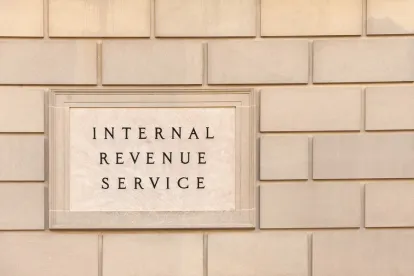On November 17, 2020, the U.S. Internal Revenue Service (“IRS”) posted new FAQs providing that an acquisition of the stock or assets of a company that has received a loan under the Paycheck Protection Program (the “PPP”) generally will not cause the acquirer and members of its aggregated employer group (as defined below) to jeopardize their employee retention tax credits (“ERTCs”). While the FAQs expressly provide that they cannot be relied upon by taxpayers, and could be withdrawn at any time, the posting of these FAQs is a very welcome development after months of requests for guidance. Although not specifically addressed by the FAQs, the approach taken in the FAQs would presumably be applied to transactions regardless of whether they occurred before or after the posting of the new FAQs.
First, the FAQs provide that if a target company has repaid a PPP loan or submitted a PPP loan forgiveness application and established an interest-bearing escrow account prior to the date the stock of the target is acquired by an unrelated acquirer, the acquirer will not be treated as having received a PPP loan, and, therefore, the acquirer (and any member of its aggregated employer group, including the target) may claim ERTCs for wages paid after the closing date, and the acquiring employer’s ERTCs for wages paid before the closing date will not be subject to recapture.[1]
Moreover, a target that has not repaid a PPP loan or established an escrow account prior to the date of the acquisition will not jeopardize ERTCs of the acquirer or its aggregated employer group, whether taken before or after the acquisition date. However, the target will be ineligible for ERTCs before and after the acquisition date.
The FAQs also confirm that an acquirer that acquires the assets of a target that has received a PPP loan will not be treated as having received a PPP loan for purposes of the ERTC by reason of the asset acquisition if the acquiring employer does not assume the target’s obligations under the PPP loan. In this case, the acquiring employer (including any member of its aggregated employer group) may claim ERTCs for wages paid after the closing date, and the acquiring employer’s ERTCs for wages paid before the closing date will not be subject to recapture.
Finally, the FAQs provide that an acquirer that acquires the assets of a target that has received a PPP loan and assumes the target’s obligations under the PPP loan will not be treated as having received a PPP loan for purposes of the ERTC. However, wages paid to employees that were employed by the target (and, presumably, members of the target’s aggregated employer group, as described below) on the closing date will not qualify for the ERTC. Otherwise, the acquirer and any member of its aggregated employer group may claim ERTCs for wages paid after the closing date, and the acquiring employer’s ERTCs for wages paid before the closing date will not be subject to recapture.
The FAQs do not address whether a target that is acquired by an acquirer that has received a PPP loan may claim the ERTC. However, it would be entirely consistent with the FAQs to conclude that such a target may claim the ERTC.
Background
The Coronavirus Aid, Relief, and Economic Security Act (the “CARES Act”) (H.R. 748) provides certain employers with an ERTC equal to 50% of certain qualified wages paid to employees from March 13, 2020 through December 31, 2020.[2] The ERTC can be used to offset federal payroll taxes such as federal wage withholding tax and the employer’s and employee’s share of social security tax and Medicare, but not the federal unemployment tax. While the ERTC is capped at $5,000 per employee, it can be significant in the aggregate: for a company with 1,000 employees, the ERTC may be as much as $5 million.
The CARES Act also provides for PPP loans and provides that PPP loans may be forgiven if certain conditions are satisfied. However, to prevent double tax benefits, the CARES Act provides that an “employer” (including members of its aggregated employer group, as described below) cannot claim the ERTC if it has received a PPP loan (unless it repaid the loan by May 18 as part of the “safe harbor” for withdrawal from the PPP program). This is so regardless of when the loan was granted.
Corporations related through greater than 50% ownership (by vote or value) are treated as members of an aggregated employer group. Also, chains of organizations (whether or not incorporated) conducting trades or businesses may be treated as an aggregated employer group if they are under common control. The test for common control depends on the types of organizations in the chain of ownership, but generally requires that corporations be connected through ownership of greater than 50% of the vote or value of each corporation and partnerships be connected through ownership of more than 50% of profits or capital.[3] Importantly, constructive (or deemed) ownership rules apply, so there may be affiliation even where not readily apparent from the face of a cap table.[4]
Without further guidance, the statutory rules described above suggest that an acquisition by an employer could result in the denial and forfeiture (i.e., recapture) of the ERTC for the acquiring employer (including any member of its aggregated employer group). For example, if a target has taken out a PPP loan, the statute appears to prohibit an acquiring employer (including any member of its pre-transaction aggregated employer group) from claiming the ERTC if it acquires a greater than 50% ownership stake in a target with a PPP loan, and to recapture any ERTCs it has already claimed. The converse also appears to apply – for example, if the acquirer has taken out a PPP loan, the target employer may be required to forfeit its ERTCs if the transaction causes the target employer to become a member of the acquirer’s aggregated employer group.
Thus, while the FAQs provide taxpayers with helpful guidance, they may not be relied upon by taxpayers, and the statute itself is unhelpful for acquirers acquiring stock of a target that has taken out a PPP loan and not repaid it by May 18. Similarly, employers that acquire the assets of a target that has received a PPP loan and assume the target’s obligations under the PPP loan cannot be certain under the statute that the assumption of the PPP loan will not cause them to be prohibited from claiming ERTCs and/or subject to recapture on any ERTCs that they have already claimed.
Although there have been multiple legislative proposals to permit an employer that receives a PPP loan to receive the ERTC by electing either to exclude qualified wages from “payroll costs” for purposes of determining its loan forgiveness under the PPP or to exclude qualified wages for purposes of calculating the ERTC, none of these proposals have directly addressed the interaction of PPP loans and the ERTC in the context of mergers and acquisitions.[5]
Conclusion
The approach taken in the IRS FAQs is taxpayer-friendly and provides some relief to ease taxpayer concerns that an acquisition of a target with a PPP loan would cause an employer to jeopardize its ERTC. However, the FAQs may not be relied on by taxpayers, and, therefore, are of limited use. Also, the FAQs do not address the treatment of a target with ERTCs that is acquired by an acquirer with an outstanding PPP loan.
[1] The IRS notes that the target must fully satisfy (i.e., repay) the PPP loan in accordance with paragraph 1 of the Small Business Administration Notice, effective October 2, 2020 (the “SBA October 2 Notice”), or submit a forgiveness application to the PPP lender and establish an interest-bearing escrow account in accordance with paragraph 2.a of the SBA October 2 Notice.
[2] Please see our blog post for more information on the ERTC.
[3] There are three ways common control is established: (i) a parent-subsidiary controlled group, where one or more chains of organizations are connected with a common parent through more than 50% ownership, (ii) a brother-sister controlled group, where two or more organizations are owned by 5 or fewer persons who are individuals, estates or trusts that own 50% or more of each organization, and more than 50% of the ownership of each organization is identical with respect to each organization, and (iii) a group of three or more organization, each of which is a member of a group of organizations described in (i) or (ii) above, in each case, the ownership percentage is based on vote or value of each corporation or profits or capital of each partnership. For this purpose, “common control” is determined based on this technical 50% ownership test, rather than the broader notion of “control” or “affiliate” from a corporate perspective or as used in the CARES Act for PPP loan purposes.
[4] In addition, even if there is minimal or no ownership overlap between entities, they could be treated as an aggregated employer group under the “affiliated service group” rules. An affiliated service group can arise if there is a service organization that regularly performs services for another organization. For example, organizations may be treated as part of an affiliated service group if the principal business of one organization is to regularly and continuously perform management services to another organization (or certain of its related organizations). Accordingly, a fund manager may be treated as part of an aggregated employer group with the portfolio companies it manages.
[5] For a summary of these proposals, please see our blog post.






 />i
/>i

